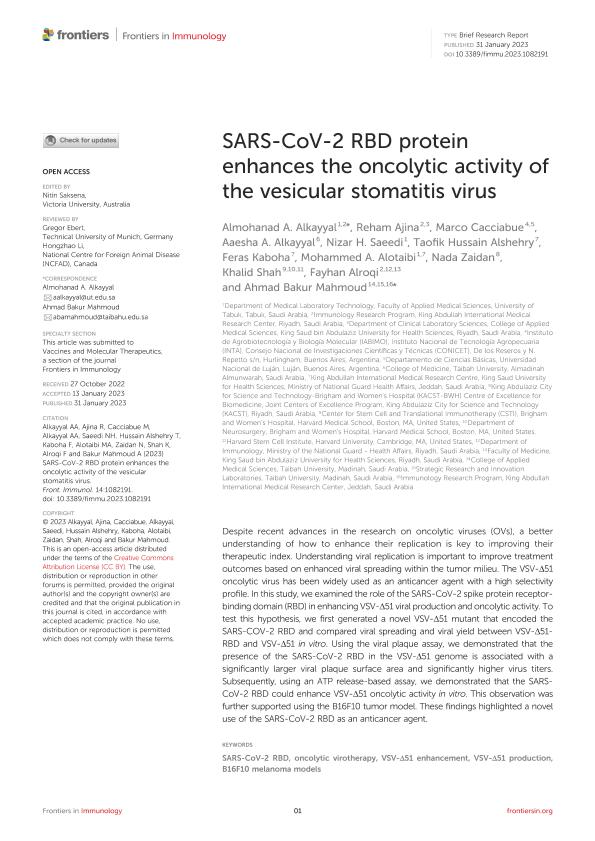Artículo
SARS-CoV-2 RBD protein enhances the oncolytic activity of the vesicular stomatitis virus
Alkayyal, Almohanad A.; Ajina, Reham; Cacciabue, Marco Polo Domingo ; Alkayyal, Aaesha A.; Saeedi, Nizar H.; Hussain Alshehry, Taofik; Kaboha, Feras; Alotaibi, Mohammed A.; Zaidan, Nada; Shah, Khalid; Alroqi, Fayhan; Bakur Mahmoud, Ahmad
; Alkayyal, Aaesha A.; Saeedi, Nizar H.; Hussain Alshehry, Taofik; Kaboha, Feras; Alotaibi, Mohammed A.; Zaidan, Nada; Shah, Khalid; Alroqi, Fayhan; Bakur Mahmoud, Ahmad
 ; Alkayyal, Aaesha A.; Saeedi, Nizar H.; Hussain Alshehry, Taofik; Kaboha, Feras; Alotaibi, Mohammed A.; Zaidan, Nada; Shah, Khalid; Alroqi, Fayhan; Bakur Mahmoud, Ahmad
; Alkayyal, Aaesha A.; Saeedi, Nizar H.; Hussain Alshehry, Taofik; Kaboha, Feras; Alotaibi, Mohammed A.; Zaidan, Nada; Shah, Khalid; Alroqi, Fayhan; Bakur Mahmoud, Ahmad
Fecha de publicación:
01/2023
Editorial:
Frontiers Media
Revista:
Frontiers in Immunology
e-ISSN:
1664-3224
Idioma:
Inglés
Tipo de recurso:
Artículo publicado
Clasificación temática:
Resumen
Despite recent advances in the research on oncolytic viruses (OVs), a better understanding of how to enhance their replication is key to improving their therapeutic index. Understanding viral replication is important to improve treatment outcomes based on enhanced viral spreading within the tumor milieu. The VSV-Δ51 oncolytic virus has been widely used as an anticancer agent with a high selectivity profile. In this study, we examined the role of the SARS-CoV-2 spike protein receptor-binding domain (RBD) in enhancing VSV-Δ51 viral production and oncolytic activity. To test this hypothesis, we first generated a novel VSV-Δ51 mutant that encoded the SARS-COV-2 RBD and compared viral spreading and viral yield between VSV-Δ51-RBD and VSV-Δ51 in vitro. Using the viral plaque assay, we demonstrated that the presence of the SARS-CoV-2 RBD in the VSV-Δ51 genome is associated with a significantly larger viral plaque surface area and significantly higher virus titers. Subsequently, using an ATP release-based assay, we demonstrated that the SARS-CoV-2 RBD could enhance VSV-Δ51 oncolytic activity in vitro. This observation was further supported using the B16F10 tumor model. These findings highlighted a novel use of the SARS-CoV-2 RBD as an anticancer agent.
Archivos asociados
Licencia
Identificadores
Colecciones
Articulos (IABIMO)
Articulos de INSTITUTO DE AGROBIOTECNOLOGIA Y BIOLOGIA MOLECULAR
Articulos de INSTITUTO DE AGROBIOTECNOLOGIA Y BIOLOGIA MOLECULAR
Citación
Alkayyal, Almohanad A.; Ajina, Reham; Cacciabue, Marco Polo Domingo; Alkayyal, Aaesha A.; Saeedi, Nizar H.; et al.; SARS-CoV-2 RBD protein enhances the oncolytic activity of the vesicular stomatitis virus; Frontiers Media; Frontiers in Immunology; 14; 1-2023; 1-7
Compartir
Altmétricas



